Garajonay: Galería multimedia
Garajonay: Galería multimedia
 El Parque Nacional es uno de los últimos refugios para la laurisilva.Todavía podemos observar cómo eran los bosques en estas latitudes hace millones de años, pues han cambiado muy poco desde entonces.
El Parque Nacional es uno de los últimos refugios para la laurisilva.Todavía podemos observar cómo eran los bosques en estas latitudes hace millones de años, pues han cambiado muy poco desde entonces.
 La laurisilva es una formación vegetal de arboles de hojas siempre verdes, que crece en lugares con una elevada humedad y una temperatura suave.
La laurisilva es una formación vegetal de arboles de hojas siempre verdes, que crece en lugares con una elevada humedad y una temperatura suave.
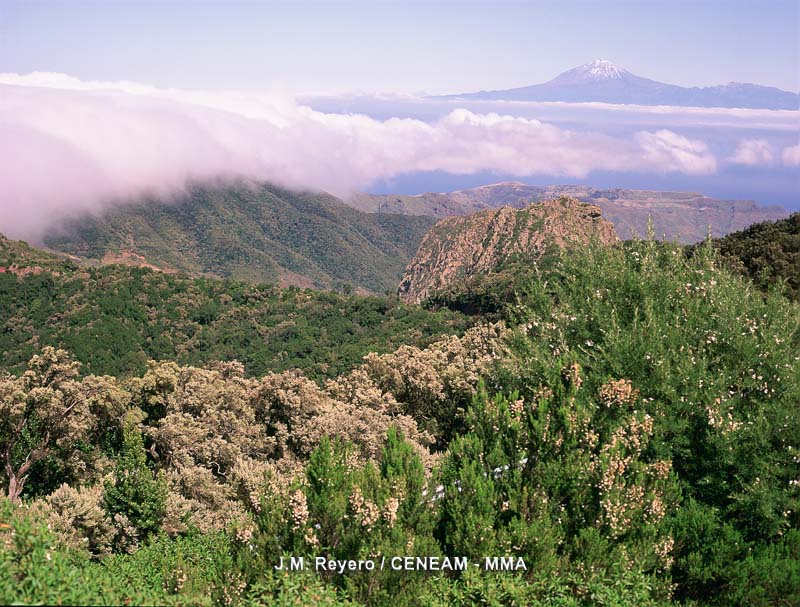 En muchos puntos del parque los brezos blancos (Erica arborea), pueden alcanzar los veinte metros de altura.
En muchos puntos del parque los brezos blancos (Erica arborea), pueden alcanzar los veinte metros de altura.
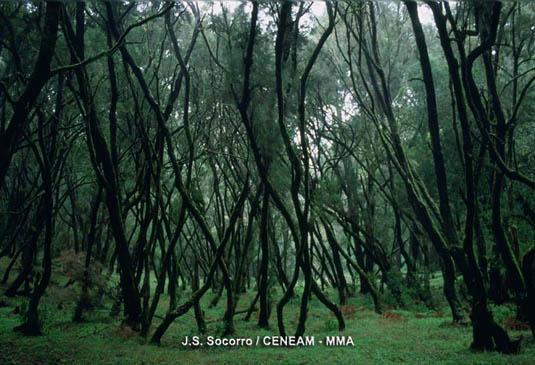 Los lugares donde la actuación humana ha sido intensa y la sequedad ambiental es alta, están cubiertos por una mezcla de fayas (Myrica faya) y brezos (Erica arborea), conocida como fayal -brezal.
Los lugares donde la actuación humana ha sido intensa y la sequedad ambiental es alta, están cubiertos por una mezcla de fayas (Myrica faya) y brezos (Erica arborea), conocida como fayal -brezal.
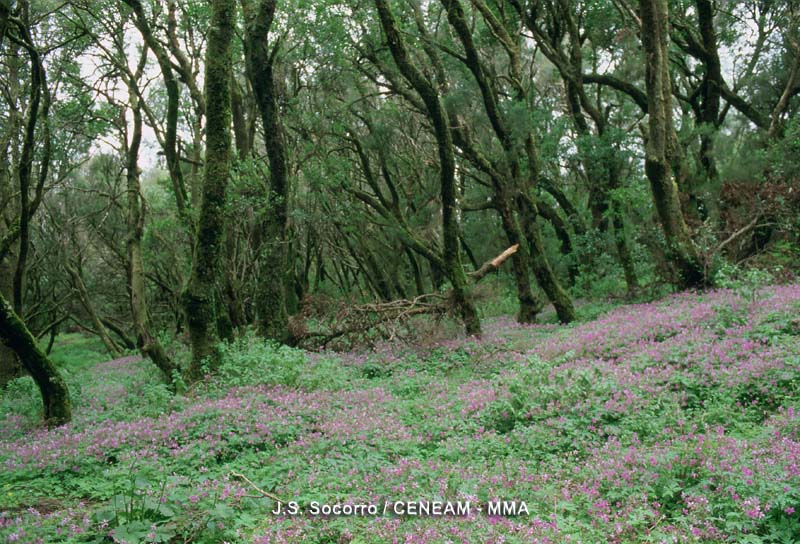 En el fayal-brezal una de las plantas que tapizan el suelo es la pata gallo (Geranium canariense).
En el fayal-brezal una de las plantas que tapizan el suelo es la pata gallo (Geranium canariense).
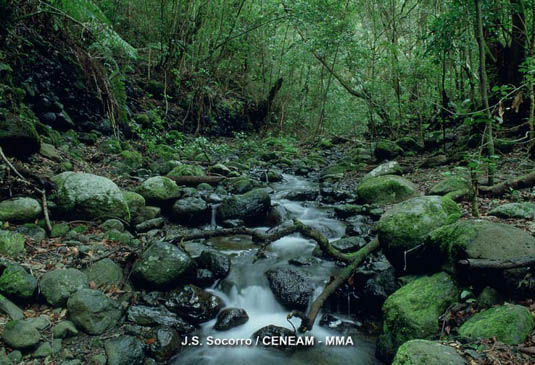 La humedad en algunos barrancos del Parque Nacional es muy elevada, porque pasan mucho tiempo cubiertos por la niebla. Por ellos discurre el agua durante casi todo el año.
La humedad en algunos barrancos del Parque Nacional es muy elevada, porque pasan mucho tiempo cubiertos por la niebla. Por ellos discurre el agua durante casi todo el año.
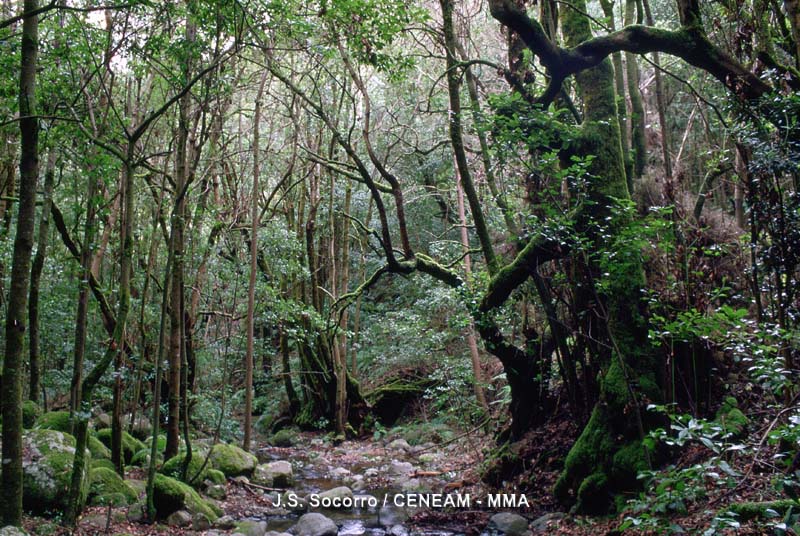 El Arroyo del Cedro es uno de los más importantes del parque nacional.
El Arroyo del Cedro es uno de los más importantes del parque nacional.
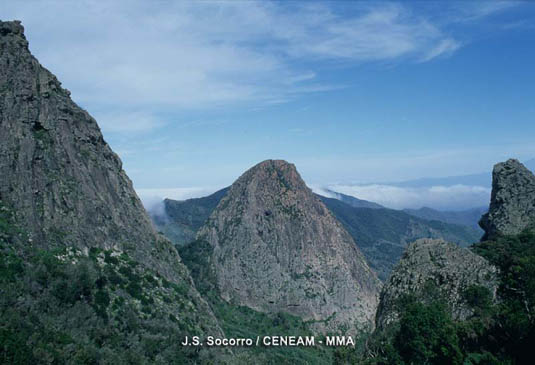 Los roques o fortalezas son los restos del magma solidificado de algunos volcanes que existieron en la isla.
Los roques o fortalezas son los restos del magma solidificado de algunos volcanes que existieron en la isla.
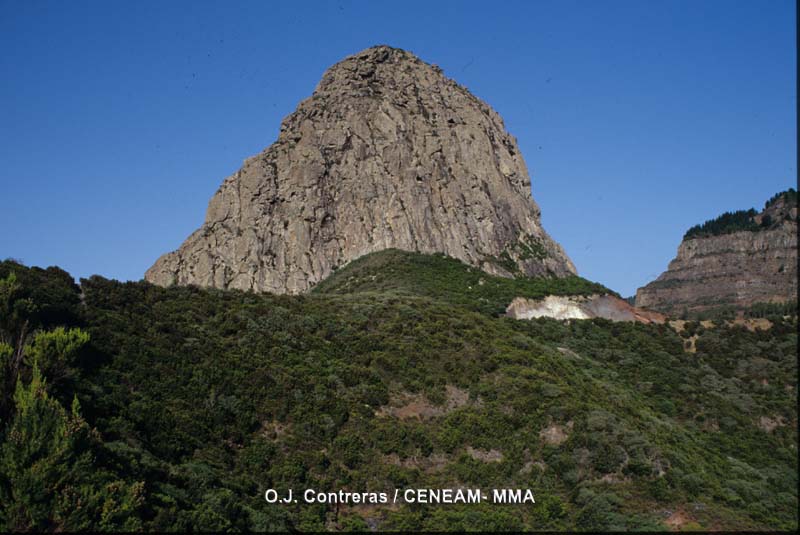 Uno de los roques más espectaculares de Garajonay es el Roque Agando.
Uno de los roques más espectaculares de Garajonay es el Roque Agando.
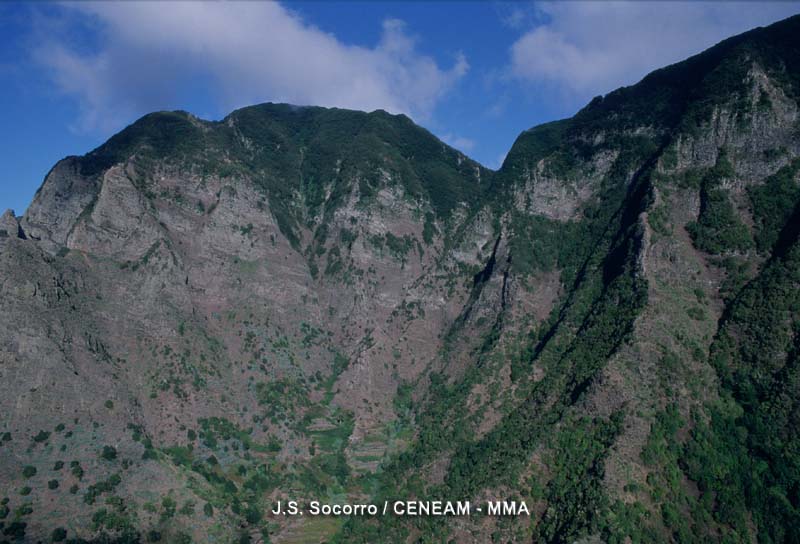 La Gomera es una isla con grandes y profundos barrancos.
La Gomera es una isla con grandes y profundos barrancos.
 El viñátigo (Persea indica), se desarrolla en los lugares más húmedos de la laurisilva.
El viñátigo (Persea indica), se desarrolla en los lugares más húmedos de la laurisilva.
 El madroño canario (Arbutus canariensis), vive en zonas secas y pedregosas de la laurisilva. Sus frutos son comestibles, en medicina popular se han utilizado para tratar la diabetes.
El madroño canario (Arbutus canariensis), vive en zonas secas y pedregosas de la laurisilva. Sus frutos son comestibles, en medicina popular se han utilizado para tratar la diabetes.
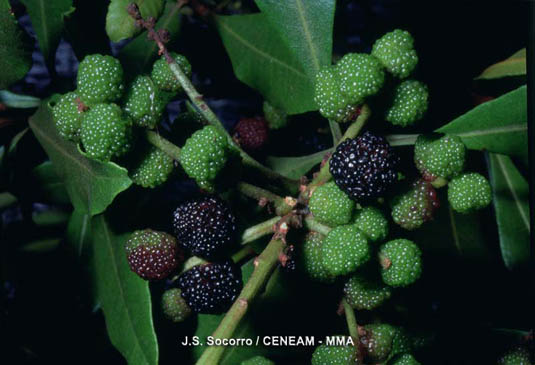 Los frutos de la faya (Myrica faya) son comestibles y sirvieron de alimento a los antiguos gomeros.
Los frutos de la faya (Myrica faya) son comestibles y sirvieron de alimento a los antiguos gomeros.
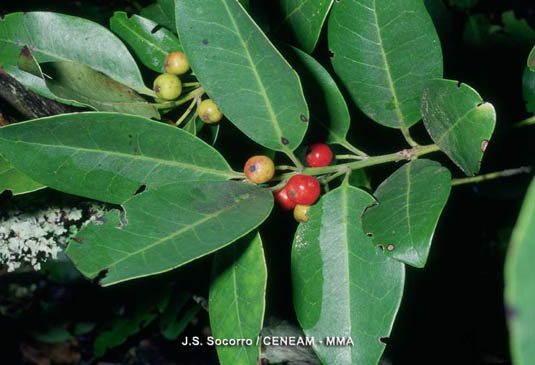 El acebiño (Ilex canariensis) vive en la laurisilva y es capaz rebrotar de raiz cuando la planta madre muere.
El acebiño (Ilex canariensis) vive en la laurisilva y es capaz rebrotar de raiz cuando la planta madre muere.
 El sauco canario (Sambucus palmensis) es una planta escasa y en peligro de extinción, que aparece en el fondo de los barrancos o en lugares muy húmedos.
El sauco canario (Sambucus palmensis) es una planta escasa y en peligro de extinción, que aparece en el fondo de los barrancos o en lugares muy húmedos.
 El taginaste (Echium acanthocarpum) sólo vive en las Isla de la Gomera. Dentro del parque crece en lugares rocosos y húmedos, entre los 800 y los 1.000 metros
El taginaste (Echium acanthocarpum) sólo vive en las Isla de la Gomera. Dentro del parque crece en lugares rocosos y húmedos, entre los 800 y los 1.000 metros
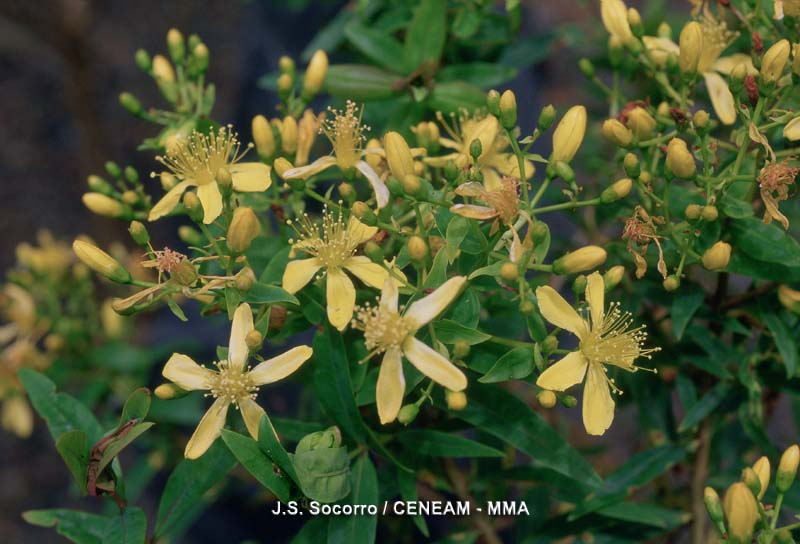 El granadillo (Hypericum canariense), vive preferentemente en zonas cálidas y aclaradas de la laurisilva.
El granadillo (Hypericum canariense), vive preferentemente en zonas cálidas y aclaradas de la laurisilva.
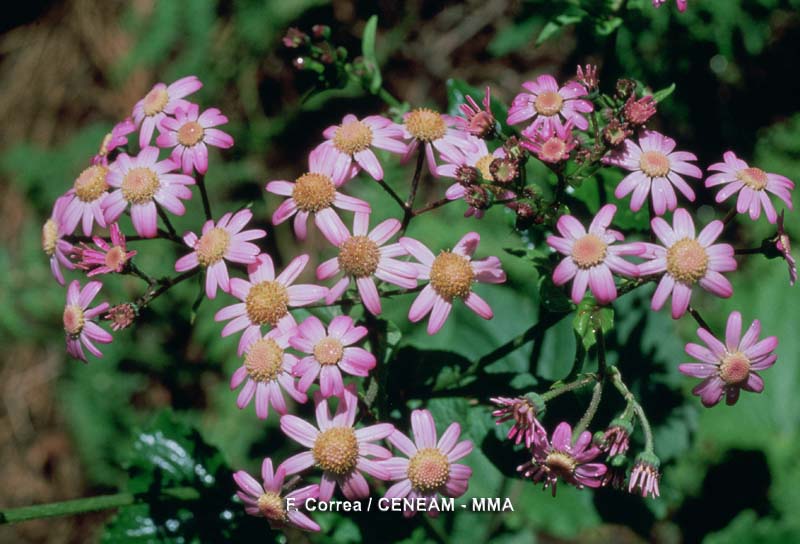 La arcila (Senecio steezii) es una planta exclusiva de la Gomera, aparece en muchos lugares siempre que haya luz.
La arcila (Senecio steezii) es una planta exclusiva de la Gomera, aparece en muchos lugares siempre que haya luz.
 Los troncos y las ramas secas de los árboles sirven de alimento a muchos hongos.
Los troncos y las ramas secas de los árboles sirven de alimento a muchos hongos.
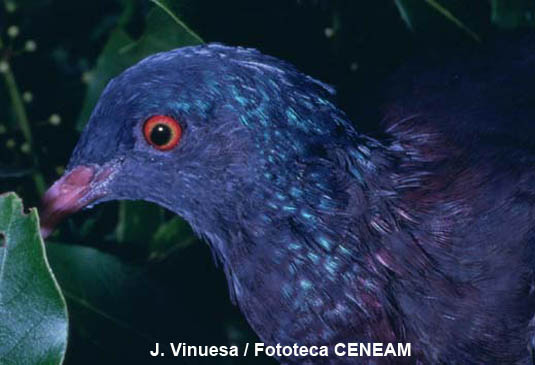 La paloma rabiche (Columba junoniae), y la paloma trurqué (Columba bollii) son las aves más representativas de la laurisilva.
La paloma rabiche (Columba junoniae), y la paloma trurqué (Columba bollii) son las aves más representativas de la laurisilva.
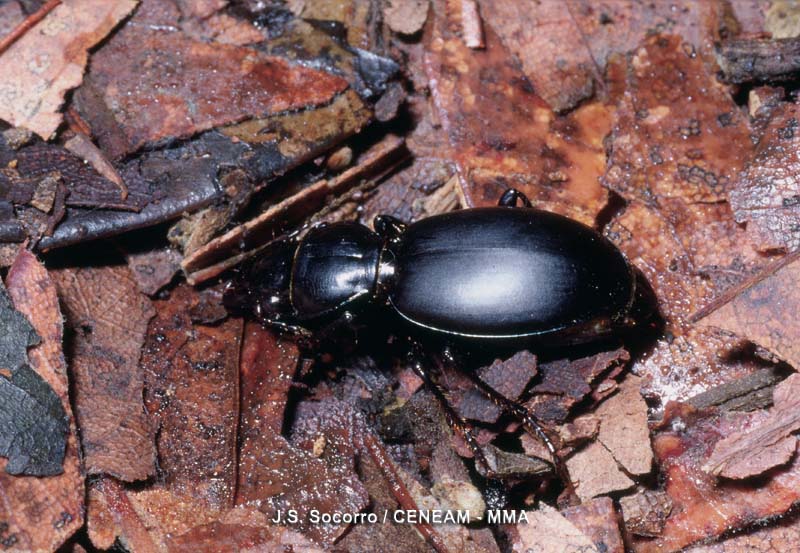 El escarabajo broscus (Broscus crassimargo), es una especie carnívora que se alimenta de lombrices y otros insectos.
El escarabajo broscus (Broscus crassimargo), es una especie carnívora que se alimenta de lombrices y otros insectos.
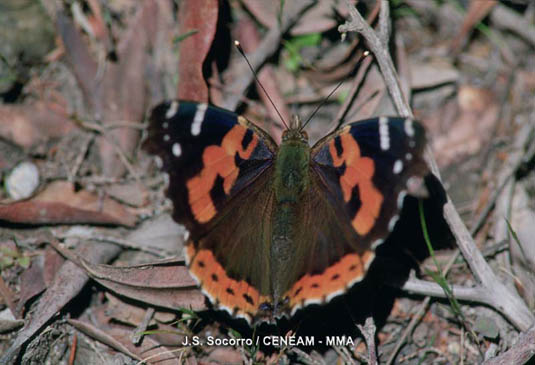 Durante los meses de mayo y junio, es frecuente ver volar mariposas como la vanesa (Vanessa vulcania) busacando flores de las que extraer el nectar.
Durante los meses de mayo y junio, es frecuente ver volar mariposas como la vanesa (Vanessa vulcania) busacando flores de las que extraer el nectar.
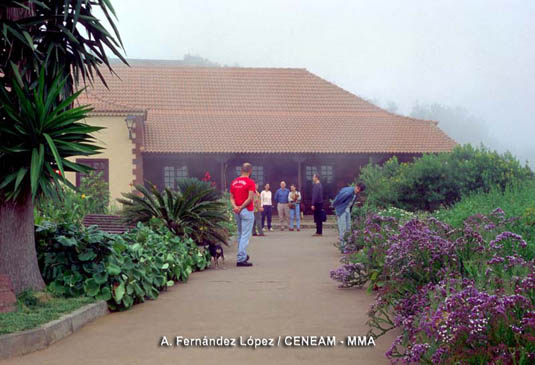 En el centro de recepción de visitantes del parque, se da una visión general de Garajonay y de la Isla de la Gomera.
En el centro de recepción de visitantes del parque, se da una visión general de Garajonay y de la Isla de la Gomera.
 Garajonay está recorrido por multitud de senderos, donde los visitantes pueden contemplar su impresionante paisaje.
Garajonay está recorrido por multitud de senderos, donde los visitantes pueden contemplar su impresionante paisaje.
 Son muchos los visitantes que cada año recorren la red de senderos del parque.
Son muchos los visitantes que cada año recorren la red de senderos del parque.
This page provides information on cookies we use: We use our own and third-party cookies to keep your session active, personalise your experience, and collect anonymous statistics about how you use this website. You can choose to accept all cookies or select which types you'd like to allow. To learn more about the cookies we use, read our Cookies Policy.
We use two types of cookies on this site. First, there are Functional Cookies, which are essential for the website to work properly. They store session data to make your experience smoother and more convenient. On the other hand, Analytical Cookies collect information about how you use the portal, without personal data, helping us provide a better and more tailored service.
Introduction to the Use of Cookies on the MITECO.gob.es Website
Cookies are small files that are stored on your device when you visit a webpage. They are essential tools that help provide many of the services available on the information society. Among other things, cookies allow a webpage to store and retrieve information about a user's browsing habits or their device. Based on this information, they can be used to recognise the user and enhance the service provided.
Types of Cookies
Depending on the entity that manages the domain from which the cookies are sent and processes the data, there are two types of cookies: first-party cookies and third-party cookies.
There is also a second classification based on how long the cookies remain stored in the user's browser: session cookies and persistent cookies.
Finally, cookies can also be classified into five types based on the purpose for which the data is processed: technical cookies, personalisation cookies, analytics cookies, advertising cookies, and behavioural advertising cookies.
For more information on this, you can refer to the Guide on the use of cookies from the Spanish Data Protection Agency.
Cookies used on the website
The web portal of the Ministry for Ecological Transition and the Demographic Challenge uses Adobe Analytics, an analytics tool that helps website and application owners understand how visitors interact with their content. Adobe Analytics uses a small number of cookies to collect data and generate usage statistics for websites. This information is sent anonymously and is not shared with third parties under any circumstances. You can choose to accept or reject these cookies, as they do not affect the portal’s functionality. However, they help provide valuable information that allows us to offer a better and more tailored service. For more information about Adobe Analytics cookies and privacy, please refer to the following links:
Additionally, pages featuring content from social network X will only set cookies if the user is logged into the X site. For more details on these cookies, please refer to the following link: Privacy on Social Network X
Finally, a technical cookie named MITECO-compliance is stored, which is a first-party, technical, and session-based cookie. It manages user consent for the use of cookies on the website, remembering which users have accepted them and which have not, ensuring that those who have accepted are not shown cookie consent messages at the top of the page. This cookie is essential for the proper functioning of the portal.
Cookies Policy Acceptance / Rejection
The Ministry for Ecological Transition and the Demographic Challenge gives you the option to accept or reject cookies that are not essential for the portal's operation. Upon accessing the portal, a message will be displayed in the centre of the page with information about the cookie policy and the following options:
· Firefox
· Chrome
· Safari